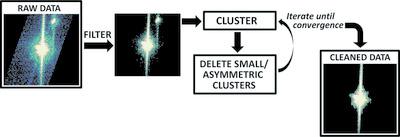当前位置:
X-MOL 学术
›
J. Appl. Crystallogr.
›
论文详情
Our official English website, www.x-mol.net, welcomes your feedback! (Note: you will need to create a separate account there.)
Removal of spurious data in Bragg coherent diffraction imaging: an algorithm for automated data preprocessing
Journal of Applied Crystallography ( IF 6.1 ) Pub Date : 2021-03-18 , DOI: 10.1107/s1600576721000819 Kenley Pelzer , Nicholas Schwarz , Ross Harder
Journal of Applied Crystallography ( IF 6.1 ) Pub Date : 2021-03-18 , DOI: 10.1107/s1600576721000819 Kenley Pelzer , Nicholas Schwarz , Ross Harder

|
Bragg coherent diffraction imaging (BCDI) provides a powerful tool for obtaining high‐resolution structural information from nanocrystalline materials. Here a BCDI sample consisting of a large number of randomly oriented nanoscale crystals is considered. Ideally, only one crystal is oriented to produce a Bragg peak on the detector. However, diffraction from other crystals often produces additional signals on the detector. Before the measured diffraction patterns can be processed into structural images, scientists routinely need to manually identify and remove the `alien' intensities from sources other than the intended crystal. With the development of modern high‐coherence storage rings, such as the upgraded Advanced Photon Source (APS), the already slow process of manual preprocessing will be untenable for the large volumes of data that will be produced. An automated method of identifying and deleting alien intensities is proposed. This method exploits the fact that BCDI of a perfect crystal produces diffraction data with inversion symmetry around the Bragg peak. This approach uses the machine learning clustering method DBSCAN to distinguish between diffraction from multiple sources, and then calculates cluster size and inversion symmetry to assess whether clusters of intensity belong to desired data or alien signals. This approach can dramatically reduce the amount of time spent manually processing data, allowing BCDI data processing capabilities to keep pace with the technological advances of fourth‐generation synchrotron light sources.
中文翻译:

布拉格相干衍射成像中的杂散数据去除:一种用于自动数据预处理的算法
布拉格相干衍射成像(BCDI)提供了一个强大的工具,可以从纳米晶体材料中获得高分辨率的结构信息。这里考虑了由大量随机取向的纳米级晶体组成的BCDI样品。理想情况下,仅定向一个晶体以在检测器上产生布拉格峰。但是,来自其他晶体的衍射通常会在检测器上产生其他信号。在将测得的衍射图样处理成结构图像之前,科学家们通常需要手动识别并消除预期晶体以外来源的“外来”强度。随着现代高相干存储环的发展,例如升级的高级光子源(APS),对于将要生成的大量数据,已经非常缓慢的手动预处理过程将是站不住脚的。提出了一种自动识别和删除外来强度的方法。该方法利用了这样一个事实,即完美晶体的BCDI会在布拉格峰附近产生具有反对称性的衍射数据。该方法使用机器学习聚类方法DBSCAN区分来自多个源的衍射,然后计算聚类大小和反演对称性,以评估强度聚类是否属于所需数据或外来信号。这种方法可以大大减少花费在手动处理数据上的时间,从而使BCDI数据处理能力与第四代同步加速器光源的技术进步保持同步。提出了一种自动识别和删除外来强度的方法。该方法利用了这样一个事实,即完美晶体的BCDI会在布拉格峰附近产生具有反对称性的衍射数据。该方法使用机器学习聚类方法DBSCAN区分来自多个源的衍射,然后计算聚类大小和反演对称性,以评估强度聚类是否属于所需数据或外来信号。这种方法可以大大减少花费在手动处理数据上的时间,从而使BCDI数据处理能力与第四代同步加速器光源的技术进步保持同步。提出了一种自动识别和删除外来强度的方法。该方法利用了这样一个事实,即完美晶体的BCDI会在布拉格峰附近产生具有反对称性的衍射数据。该方法使用机器学习聚类方法DBSCAN区分来自多个源的衍射,然后计算聚类大小和反演对称性,以评估强度聚类是否属于所需数据或外来信号。这种方法可以大大减少花费在手动处理数据上的时间,从而使BCDI数据处理能力与第四代同步加速器光源的技术进步保持同步。该方法利用了这样一个事实,即完美晶体的BCDI会在布拉格峰附近产生具有反对称性的衍射数据。该方法使用机器学习聚类方法DBSCAN区分来自多个源的衍射,然后计算聚类大小和反演对称性,以评估强度聚类是否属于所需数据或外来信号。这种方法可以显着减少手动处理数据所花费的时间,从而使BCDI数据处理能力与第四代同步加速器光源的技术进步保持同步。该方法利用了这样一个事实,即完美晶体的BCDI会在布拉格峰附近产生具有反对称性的衍射数据。该方法使用机器学习聚类方法DBSCAN区分来自多个源的衍射,然后计算聚类大小和反演对称性,以评估强度聚类是否属于所需数据或外来信号。这种方法可以大大减少花费在手动处理数据上的时间,从而使BCDI数据处理能力与第四代同步加速器光源的技术进步保持同步。然后计算聚类大小和反演对称性,以评估强度聚类是否属于所需数据或外来信号。这种方法可以大大减少花费在手动处理数据上的时间,从而使BCDI数据处理能力与第四代同步加速器光源的技术进步保持同步。然后计算聚类大小和反演对称性,以评估强度聚类是否属于所需数据或外来信号。这种方法可以大大减少花费在手动处理数据上的时间,从而使BCDI数据处理能力与第四代同步加速器光源的技术进步保持同步。
更新日期:2021-04-06
中文翻译:

布拉格相干衍射成像中的杂散数据去除:一种用于自动数据预处理的算法
布拉格相干衍射成像(BCDI)提供了一个强大的工具,可以从纳米晶体材料中获得高分辨率的结构信息。这里考虑了由大量随机取向的纳米级晶体组成的BCDI样品。理想情况下,仅定向一个晶体以在检测器上产生布拉格峰。但是,来自其他晶体的衍射通常会在检测器上产生其他信号。在将测得的衍射图样处理成结构图像之前,科学家们通常需要手动识别并消除预期晶体以外来源的“外来”强度。随着现代高相干存储环的发展,例如升级的高级光子源(APS),对于将要生成的大量数据,已经非常缓慢的手动预处理过程将是站不住脚的。提出了一种自动识别和删除外来强度的方法。该方法利用了这样一个事实,即完美晶体的BCDI会在布拉格峰附近产生具有反对称性的衍射数据。该方法使用机器学习聚类方法DBSCAN区分来自多个源的衍射,然后计算聚类大小和反演对称性,以评估强度聚类是否属于所需数据或外来信号。这种方法可以大大减少花费在手动处理数据上的时间,从而使BCDI数据处理能力与第四代同步加速器光源的技术进步保持同步。提出了一种自动识别和删除外来强度的方法。该方法利用了这样一个事实,即完美晶体的BCDI会在布拉格峰附近产生具有反对称性的衍射数据。该方法使用机器学习聚类方法DBSCAN区分来自多个源的衍射,然后计算聚类大小和反演对称性,以评估强度聚类是否属于所需数据或外来信号。这种方法可以大大减少花费在手动处理数据上的时间,从而使BCDI数据处理能力与第四代同步加速器光源的技术进步保持同步。提出了一种自动识别和删除外来强度的方法。该方法利用了这样一个事实,即完美晶体的BCDI会在布拉格峰附近产生具有反对称性的衍射数据。该方法使用机器学习聚类方法DBSCAN区分来自多个源的衍射,然后计算聚类大小和反演对称性,以评估强度聚类是否属于所需数据或外来信号。这种方法可以大大减少花费在手动处理数据上的时间,从而使BCDI数据处理能力与第四代同步加速器光源的技术进步保持同步。该方法利用了这样一个事实,即完美晶体的BCDI会在布拉格峰附近产生具有反对称性的衍射数据。该方法使用机器学习聚类方法DBSCAN区分来自多个源的衍射,然后计算聚类大小和反演对称性,以评估强度聚类是否属于所需数据或外来信号。这种方法可以显着减少手动处理数据所花费的时间,从而使BCDI数据处理能力与第四代同步加速器光源的技术进步保持同步。该方法利用了这样一个事实,即完美晶体的BCDI会在布拉格峰附近产生具有反对称性的衍射数据。该方法使用机器学习聚类方法DBSCAN区分来自多个源的衍射,然后计算聚类大小和反演对称性,以评估强度聚类是否属于所需数据或外来信号。这种方法可以大大减少花费在手动处理数据上的时间,从而使BCDI数据处理能力与第四代同步加速器光源的技术进步保持同步。然后计算聚类大小和反演对称性,以评估强度聚类是否属于所需数据或外来信号。这种方法可以大大减少花费在手动处理数据上的时间,从而使BCDI数据处理能力与第四代同步加速器光源的技术进步保持同步。然后计算聚类大小和反演对称性,以评估强度聚类是否属于所需数据或外来信号。这种方法可以大大减少花费在手动处理数据上的时间,从而使BCDI数据处理能力与第四代同步加速器光源的技术进步保持同步。



























 京公网安备 11010802027423号
京公网安备 11010802027423号